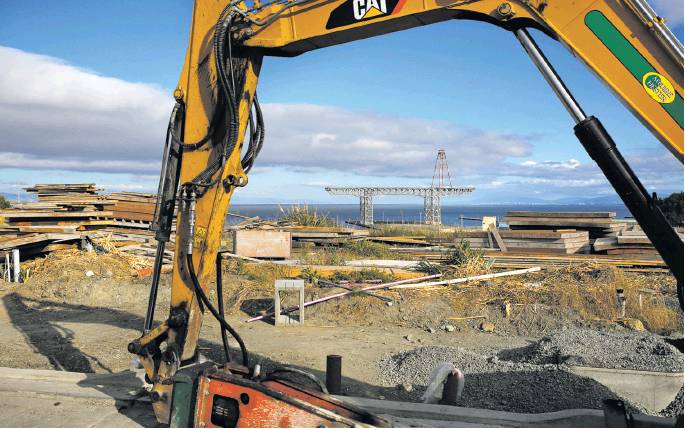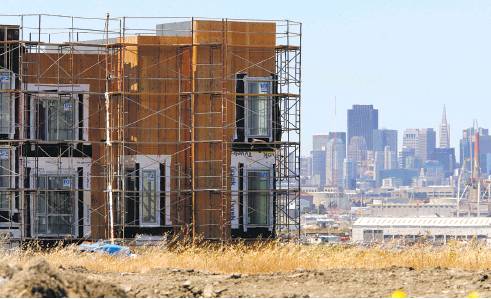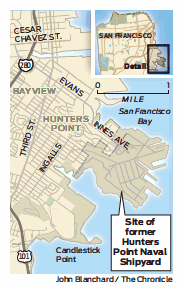Toxic dirt from S.F. may be far and wide
Ex-Hunters Point workers say soil went to landfills
By J.K. Dineen
The scandal involving cheating in the $1 billion cleanup at the former Hunters Point Naval Shipyard has until now focused on allegations of what was left behind at the site: radioactive dirt dumped into trenches to save the time and expense of testing and disposing of it properly.
But former shipyard employees and environmentalists say that toxic waste removed from the site is of just as great a concern. Soil with potentially dangerous levels of radioactive waste, they contend, was trucked to conventional landfills across California — the sort of dumps that typically fill up with tree branches, construction debris and old dishwashers, not radiological waste from a former nuclear test lab that handled uranium and plutonium.
The shipyard, home to the Naval Radiological Defense Laboratory from 1946 to 1969, is now the site of the San Francisco Shipyard development project, regarded as perhaps the most important development site in the city. It is to contain more than 10,500 housing units, 300 acres of open space, millions of square feet of retail, schools, a hotel and artists studios.
Before developer FivePoint starting building condominiums in 2013, former shipyard employees say that Tetra Tech, the company that was paid between $350 million and $450 million to lead the cleanup of the site, relaxed the standards for what was allowed to leave the property starting in 2011. The portal monitors — radiation detection scanners used to prevent trucks containing dangerous materials from exiting — were reset to be less sensitive. An area with scaffolding that allowed inspectors to get on top of the trucks to inspect shipments was taken down.
And whereas previously trucks that set off an alert from the portal monitor more than twice would be made to dump their soil loads back on a tarp to be retested and cleaned of dangerous materials, the new policy just required an employee to walk around the truck with a handheld monitor. Those monitors rarely detected anything because the truck bed made it tough to get readings, according to workers.
Former shipyard employee Susan Andrews, who operated portal monitors in 2010 and 2011, said Tetra Tech management went to extreme lengths to ensure trucks were allowed to exit, no matter how many times they set off the radiation detector.
“Before 2011 that dirt was never to leave until the radiation detected was found, contained and put in a secure lockup box,” she said. “In 2011, they changed the way they did business.”
Andrews said she saw trucks leaving the yard at night after the portal where they exited was supposed to be closed for the day — something she witnessed in January and February of 2012 from her condominium on Cleo Rand Lane, right above the shipyard entrance. She was one of nine former Tetra Tech employees to raise concerns with the Nuclear Regulatory Commission. She said she was laid off a short time later.
“I would be out with my dog about an hour after everyone had gone home, and I’d see these trucks full of dirt — 10 or 15 of them — going right by my condo,” she said. “It was crazy. Where on the site the dirt was coming from or where it was going I don’t know. But nothing should have been leaving after the portal monitor was shut down” for the night.
A recent review by the U.S. Environmental Protection Agency and state agencies found that as much as 97 percent of Tetra Tech’s cleanup data for two parcels at the shipyard was found to be suspect and should be retested, according to John Chesnutt, manager of the EPA’s local Superfund Division. A spokesman for Tetra Tech did not return a call seeking comment.
While the Navy has acknowledged the problems with the Tetra Tech work, it continues to insist that the materials were removed from the site properly and safely.
Derek Robinson, who is leading the cleanup for the Navy, said soil is stockpiled on-site and sampled to “to select the appropriate landfill for disposal.” Soil that meets both radiological and chemical cleanup requirements is put back into trenches on the site, places where structures may later be built.
Soil that doesn’t meet those standards is separated and either sent to a landfill that accepts specific types of contamination in the soil or to a low-level radioactive waste site.
Some batches of dirt hauled off Hunters Point were tested and deemed too “hot” for conventional dumps, meaning they contained unacceptably high levels of radionuclides like cesium 137 and strontium 90 — both can cause cancer. That dirt, at least 4,300 cubic yards, was transported in watertight steel bins to Clive, Utah, one of four disposal sites in the United States licensed to accept low-level radioactive waste.
The rest of the waste, the vast majority, about 7,800 truckloads carrying 156,000 cubic yards, was marked “nonhazardous” and went to conventional dumps.
It was hauled to Kirby Canyon in Morgan Hill, near San Jose. It was transported to Keller Canyon in Pittsburg. It went to a dump in Buttonwillow, near Bakersfield, and to facilities in Vacaville and Brisbane owned by Recology, which collects San Francisco’s household trash. Most landfills also have portal monitors, although environmental experts say they are used sporadically and do not test for radiation. If soil contaminated with radioactive material left the shipyard site without being properly vetted, it is possible it landed in one of these landfills.
The timing of the changes Andrews observed at the portal is consistent with testimony from other whistle-blowers, who say the entire culture of the cleanup changed in early 2011 when Tetra Tech’s contract was restructured from “time and material” to a “firm fixed-price model.” Suddenly, the contractor had a financial incentive to complete the cleanup as quickly as possible because it was working for a specific dollar amount.
Shortly after that contract change, worker and whistle-blower Bert Bowers, who was in charge of monitoring compliance with Nuclear Regulatory Commission standards, said he started to see violations of industry standards — equipment left where it shouldn’t be and employees working without proper oversight. He complained and was later fired.
“The incentive was there to cut corners and get bonuses, and I started to see the effect,” he said. “The standards started to become compromised.”
Anthony Smith, who worked as laborer and technician at the shipyard during that time, said he and his colleagues spent months taking soil from areas known to be clean — like the foundation of an old movie theater — and passing it off as coming from sections of the site known to be highly toxic.
“It came down from the higher-ups — ‘We’re gonna make this clean today. Go get a sample from the normal place, go get a clean sample,’ ” Smith said.
Lindsey Dillon, a professor of sociology at UC Santa Cruz who is writing a book about the cleanup and redevelopment of the shipyard, said it’s ironic that the champions of the redevelopment project cast it as “the heroic story of cleaning up a toxic military base” while the waste taken off the property is “creating a new geography of toxic exposure.”
Conventional landfills tend to be located in communities lacking economic or politic clout.
“It’s a systemic issue, because these landfill sites are located in particularly vulnerable areas,” said Dillon.
Don Wadsworth, a health physicist who specializes in radiation safety and radioactive waste management services, said the classified nature of Hunters Point’s history makes it hard to know what is buried on the property. But the federal government allocated plenty of money to do the job correctly.
“The problem you have is that Tetra Tech was on a program of deceiving the client and the regulators about the conditions on the site and the conditions of the materials leaving the site,” said Wadsworth. “In this case, the safety guard rails were not only ignored, they were ripped up and thrown away.”
Daniel Hirsch, retired director of the Environmental and Nuclear Policy Program at UC Santa Cruz, said the “release criteria” governing waste materials the Navy set at the shipyard were far lower than they should have been. And it is problematic that those standards may have been violated.
Hirsch said he has spent two years trying to find out what happened to the materials removed from the shipyard.
“The Navy have resisted and resisted and resisted,” he said. “My impression is that they knew this was a potential problem and didn’t want it exposed.”
Landfills sell material as well as accept it so it’s tough to say where all material from the shipyard wound up. Hunters Point soil could have ended up in rural roads, parks or building sites, Hirsch said. It could have been used as “cover” at landfills and ended up blown into nearby neighborhoods. It could contaminate water tables and irrigation used for crops.
In addition, waste and unwanted furnishings and metals such as pipes salvaged from razed buildings on the site could be recycled. Contaminated office furniture, fencing, metals and concrete from buildings all could have ended up in places where they could do harm to an unsuspecting public.
“I predict those communities will be up in arms, and they should be,” Hirsch said. “They have converted one Superfund site into perhaps many.”
Several of the waste removal and recycling companies that received soil and debris from the shipyard did not return calls.
Recology, which owns facilities in Vacaville and Brisbane, said it would review all shipments from Hunters Point. Spokesman Eric Potashner said his facilities require customers to sign a guarantee that the soil doesn’t contain contaminants that are not accepted, which would include anything radioactive.
“We have a robust sampling and acceptance criteria for all waste that comes into the site,” he said.
Andrews, who is from West Virigina, said Tetra Tech should be responsible for conducting tests at the landfills where the shipyard soil ended up. She said that her co-workers went along with the program because the Hunters Point jobs were the most lucrative in the country for workers in the hazardous waste remediation field. They paid $42 an hour plus $1,500 a week in expenses. Most of the workers were from Southern states where that kind of money goes a long way.
“I was told to shut my mouth, that I didn’t live there, had hit the lottery, that I should shut up and save my money. The more they said that, the madder I got,” she said. “I did care, and I decided that the people of San Francisco were worth more than my salary.”
J.K. Dineen is a San Francisco Chronicle staff writer. Email: jdineen@sfchronicle.com Twitter: @sfjkdineen



